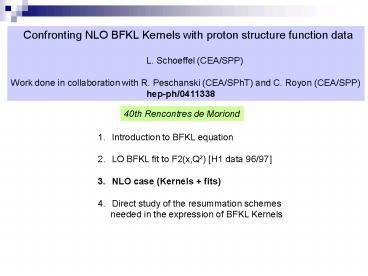Diapositive 1 - PowerPoint PPT Presentation
Title:
Diapositive 1
Description:
Confronting NLO BFKL Kernels with proton structure function data. L. ... Direct studies of the resum. schemes in Mellin space ... New resum. schemes... Summary ... – PowerPoint PPT presentation
Number of Views:12
Avg rating:3.0/5.0
Title: Diapositive 1
1
Confronting NLO BFKL Kernels with proton
structure function data
L. Schoeffel
(CEA/SPP) Work done in collaboration with R.
Peschanski (CEA/SPhT) and C. Royon (CEA/SPP)
hep-ph/0411338
40th Rencontres de Moriond
- Introduction to BFKL equation
- LO BFKL fit to F2(x,Q²) H1 data 96/97
- NLO case (Kernels fits)
- Direct study of the resummation schemes
- needed in the expression of BFKL Kernels
2
Introduction to BFKL equation (in DIS)
- F2 well described by DGLAP fits
- What happens if ?S Ln(Q²/Q0²) ltlt ?S Ln(1/x) ?
- gt Needs a resummation of ?S Ln(1/x) to all
orders - (by keeping the full Q² dependence)
- gt Relax the strong ordering of kT²
- gt We need an integration over the full kT space
- xG(x,Q²) ? dkT²/kT² f(x,kT²)
?
BFKL equation relates fn and fn-1 (fn K ? fn-1)
gt f(x, kT²) x-? ? kT diffusion term gt
increase of F2(x,Q²) at low x
p
3
F2 expression from the BFKL Kernel at LO
After a Mellin transform in x and Q², F2 can be
written as F2(x,Q²) ?? d?d? /(2i??)²
(Q²/Q0²)? x-? F2(?,?) At LO F2(?,?) H(?,?) /
? - ? ?LO(?) with ? ?S 3/? ?LO(?) is the
BFKL Kernel 1/? 1/(1-?)
For example DGLAP at LO would give
?(?)1/? H(?,?) is a regular function and the
pole contribution ? ? ?LO(?) leads to a
unique Mellin transform in ?. Then, a saddle
point approx. at low x gt
F2(x,Q2) N exp½L?Y?LO(½)-½L2/(??LO(½)Y)
Q/Q0 x-?? ?(½)
L Ln(Q2/Q02) et Y Ln(1/x)
Note ?c ½ is the saddle point
4
Results at LO
F2(x,Q2) N exp½L?Y?LO(½)-½L2/(??LO(½)Y)
Q/Q0 x-?? ?(½)
L Ln(Q2/Q02) et Y Ln(1/x)
- Very good description of F2 at
- low xlt0.01 with a 3 parameters
- fit // global QCD fit of H1
- We get
- Q0² 0.40 /- 0.01 GeV²
- and ? 0.09 /- 0.01 ? ?S 3/?
- gt Much lower than the typical
- value expected here ? 0.25
- gt Higher orders (NLO) corr.
- needed with ?S running (RGE)
F2 (measured by H1 96-97 data)
5
BFKL Kernel(s) at NLO
LO case
NLO BFKL Kernels ?(?,?,?)
- Calculations at NLO
- gt singularities
- gt resummation required by
- consistency with the RGE
- (different schemes aviable)
- Consistency condition at NLO
- ?NLO(?, ?, ?RGE) verifies the relation
- ?p ?RGE ?NLO(?, ?p,?RGE)
- // LO condition ? ? ?LO(?)
Numerically gt ?p(?,?RGE) Then we get
?NLO(?, ?p,?RGE) ?? ?eff(?,?RGE)
6
Deriving F2(x,Q²) from BFKL at NLO
Saddle point approximation in ? (// LO case)
F2(x,Q2) N exp?cL?RGEY?eff(?c,
?RGE)-½L2/(?RGE?eff(?c,?RGE)Y)
L Ln(Q2/Q02) et Y Ln(1/x)
with ?c ?saddle such that ?eff(?c,) 0
NLO and LO values of the intercept are
compatible For a reasonnable value of ?RGE
7
Results at NLO
- F2 compared with
- LO predictions and
- 2 schemes at NLO
- Sizeable differences are
- visible between the two resummation schemes at
NLO - The LO fit (with 3 param.) gives a much better
description than NLO fit (2 param.) - for Q²lt8.5 GeV²
gt Pb with the saddle pt approx? gt Pb with the
NLO Kernels?
8
Study of the consistency relation at
NLO Determination of ?saddle(?,Q²)
From F2(?,Q²) ? d?/(2i??) (Q²/Q0²)? f(?,?) gt
?lnF2(?,Q2)/?lnQ2 ?(?,Q2) Then we can
determine ?(?,Q2)?saddle from
parametrisations of F2 data(x,Q²) -gt F2(?,Q2) -gt
?saddle Then, we will study the consistency
relation ? ?RGE(Q2) ?NLO(?(),
?,?RGE) (reminiscent from the similar relation
at LO)
9
Consistency relation
From ? (?, ltQ2gt) gt we determine ?NLO(?,?,?RGE)
- and verify the relation
- ?NLO(?,?,?RGE)? /?RGE(ltQ2gt) ?
- In black ?NLO(?,?,Q²)
- In Red ? /?RGE(ltQ2gt)
- The consistency relation does not
- hold exactly BUT ?NLO(?,?,Q²)
- is linear in ? and does not diverge
- gt spurious singularities properly
- resummed! (it is not the case for
- all schemes)
- In practice we have
- ?NLO(?,?,?RGE) ? / ?OUT
- Note Recalculating ?eff with this
- relation does not change the results
- on the F2(x,Q²) fits
10
Summary
- Effective approximation of the BFKL Kernels at
NLO - gt 2 parameters formula for F2(x,Q²) at low
xlt0.01 - gt Reasonnable description of the F2 data
- gt Sensitivity to the resum. schemes pb with
the 2 lowest Q² bins - Direct studies of the resum. schemes in Mellin
space - gt The consistency relation holds approximately
- gt Discrimination of the different schemes /
existence of spurious singularities - Further studies
- Beyond the saddle point approximation
- unknown aspects of prefactors could
play a role (NLO impact factors) - New resum. schemes































